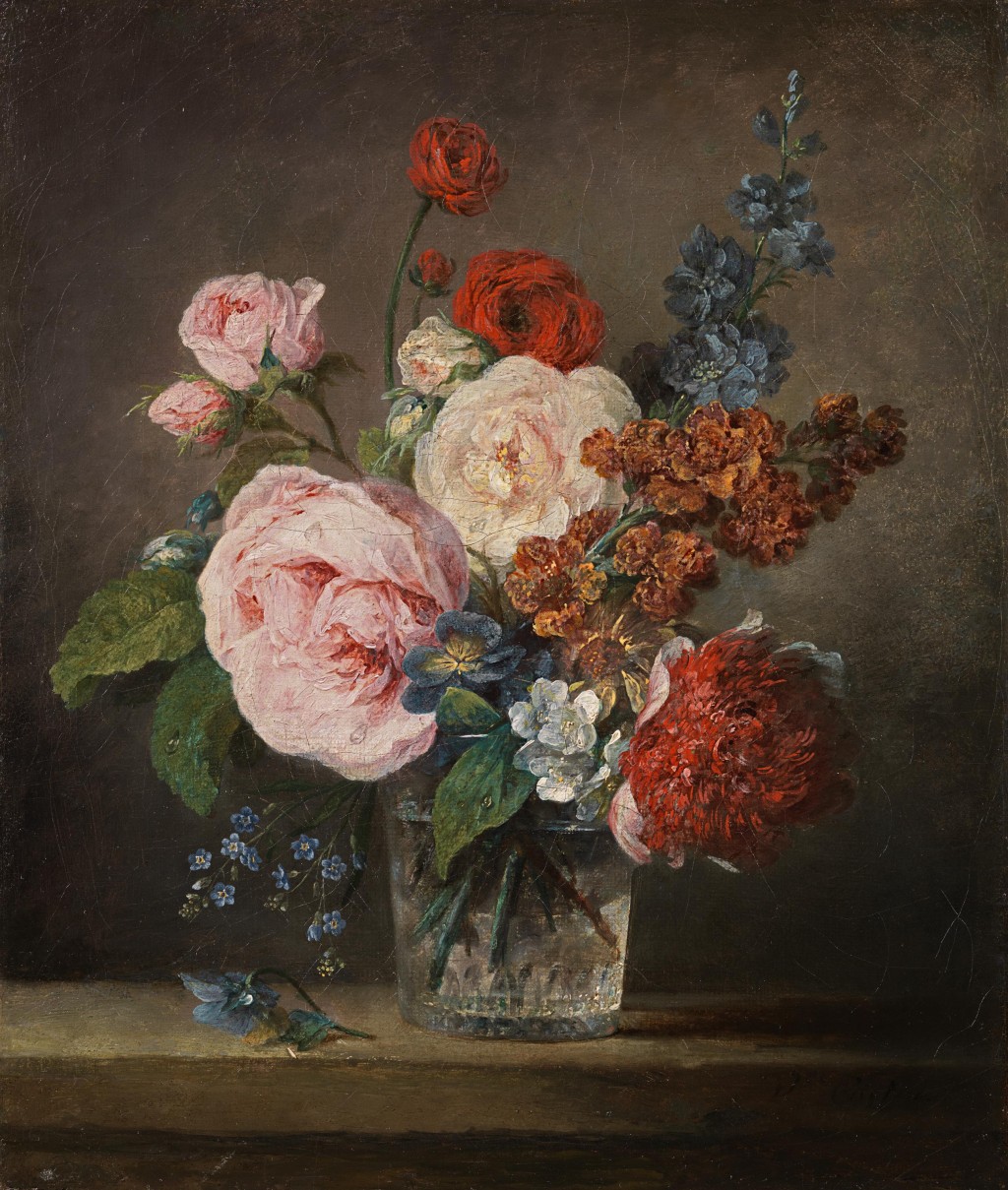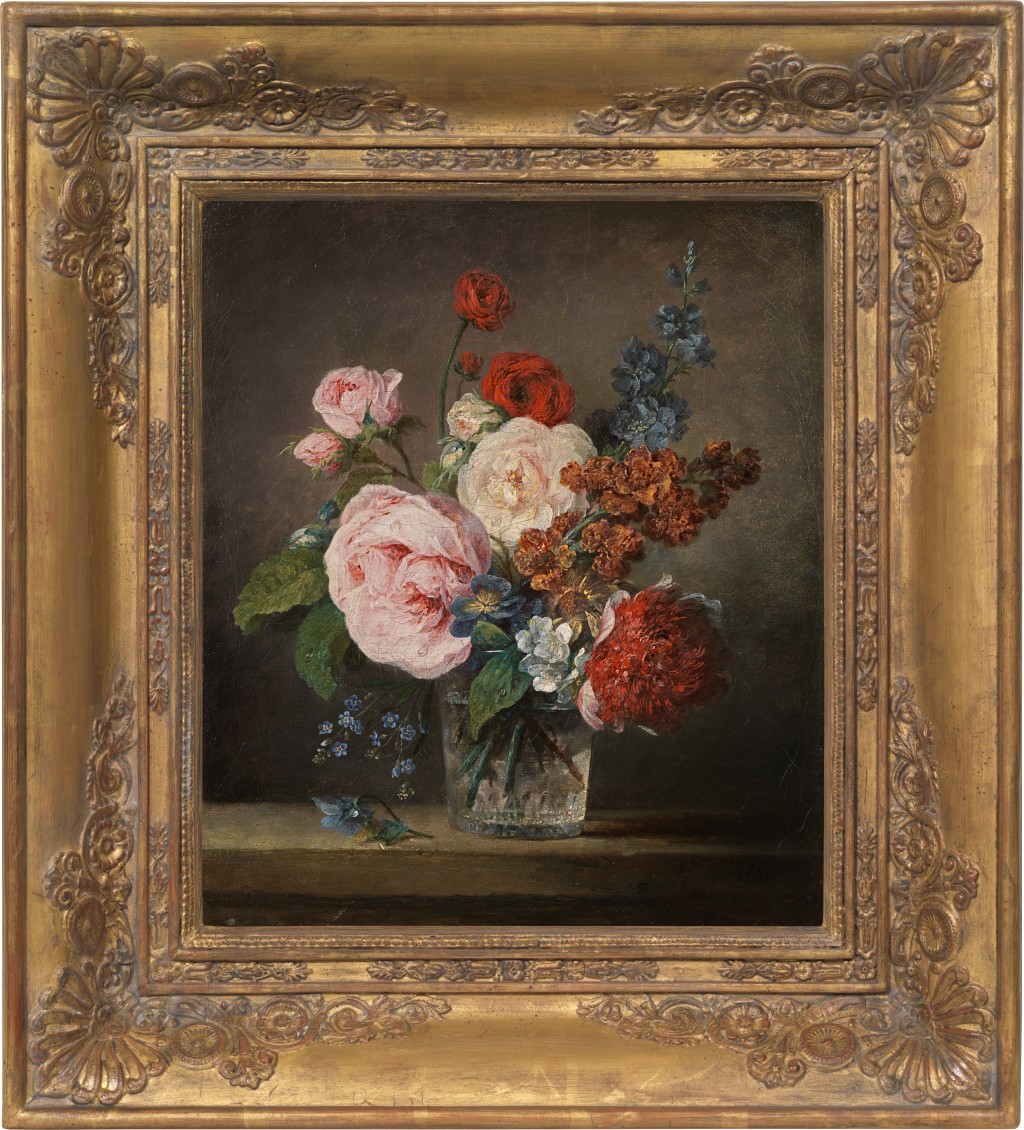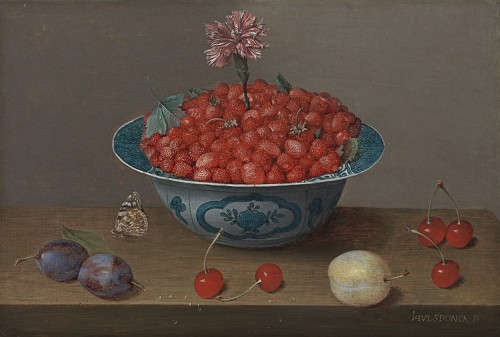ANNE VALLAYER-COSTER
1744 – Paris - 1818
Ref: CB 136
Vase de fleurs
Signed lower right: Ver. Coster
Oil on canvas: 12 ¾ x 11 in / 32.4 x 27.9 cm
Frame size: 18 ½ x 16 ½ in / 47 x 41.9 cm
Painted circa 1805
Provenance:
Private collection, France
Anne Vallayer-Coster had a distinguished career in the last years of France’s ancien régime, unusual for one of her sex. The daughter of two artists – a goldsmith and a miniature painter – she became a member of the Académie Royale in 1770 at the age of twenty-six, one of only a handful women to hold this honour before the French Revolution. Vallayer-Coster was given Royal commissions, painting Louis XVI’s spinster aunts, Mesdames Sophie, Victoire and Adelaïde (1779-80; Château de Versailles). She attracted the attention of Queen Marie-Antoinette, who was a signatory in 1781 to Vallayer’s marriage contract with the avocat de parlement and tax collector Jean-Pierre-Silvestre Coster. Henceforth she signed her work Vallayer-Coster. It was a marriage of equals, at the very least: Vallayer brought personal savings of 14,000 livres (partly from her earnings as an artist) and an inheritance of 20,000 livres to the union, while her husband’s assets were 15,000 livres.
Vallayer-Coster’s delicate, fluid touch and clear, bright palette were very much in tune with the aesthetic of Marie-Antoinette, which combined neoclassical simplicity with playfulness and a love of the natural world. Vallayer-Coster built up a formidable reputation as a still life and flower painter. After she was elected to the Académie and exhibited at the Salon of 1771, Diderot wrote: ‘It is certain that if all new members made a showing like Mademoiselle Vallayer’s, and sustained the same high level of quality there, the Salon would look very different!’[1]. The celebrated portraitist Elizabeth Vigée-Lebrun (1755-1842) wrote in her memoirs of ‘Madame Vallayer-Coster, who painted flowers perfectly’.
Vase de fleurs is an exquisite example of Vallayer-Coster’s smaller-scale flower pieces. She sets a few early summer blooms, carefully chosen for their tonal contrasts, in a simple glass vase which limpidly refracts the light and the complex shadows of the stalks. Vallayer-Coster’s brushwork sensuously caresses the intricate petals of the roses and delineates the ruffled cups of the scarlet ranunculas which crown the bouquet. The warm tones of the roses, ranunculas and peony are offset by the cool blues of the delphinium, pansies and forget-me-nots, which form a diagonal from top right to bottom left.
Vallayer-Coster sets the bouquet on an unadorned stone ledge against a plain background of soft grey which enhances the sculptural solidity of the flowers. A deep shadow to the right throws into relief the light shining on the glass vase, a passage of painting of brilliant virtuosity. In her choice of plain backgrounds, Vallayer-Coster was probably influenced by the still lifes of her celebrated, older contemporary Jean-Baptiste-Siméon Chardin (1699-1779). Her palette, based around pure but never strident blue, pink, red and glowing white highlights, also has parallels with Chardin’s. She was also interested in the great Dutch tradition of still life painting, owning a still life (the only still life in her collection, apart from her own works) by Jan Davidsz. de Heem (1606-1683/4)[2]. Vallayer-Coster’s style, which combines botanical accuracy with a delight in the tactile qualities of paint, looks forward to the flower paintings of Henri Fantin-Latour (1836-1904).
ANNE VALLAYER-COSTER
1744 - Paris - 1818
Anne Vallayer was the daughter of Joseph Vallayer (1704-1770), a royal goldsmith who worked at the Gobelins manufactory before setting up his own business specialising in snuff boxes. Her mother was the miniature painter Anne Desfontaines. She was born in the Gobelins complex and lived there until the age of ten. Anne may have studied with Madeleine Basseporte (1701-1780), who instructed Mesdames, Louis XV’s daughters, and was the official draughtswoman for the Jardin des Plantes. She also had lessons in landscape painting from Claude-Joseph Vernet (1714-1789). In 1770 she was reçue at the Académie Royale upon presentation of two still lifes, Attributes of Painting and Musical instruments (Louvre). Only four women were accepted into the Académie before the Revolution. Anne Vallayer-Coster exhibited at the Paris Salon from 1771 to 1817.
Vallayer gained aristocratic patrons, including the Prince de Conti and the Marquis de Marigny. In 1779 she painted Madame Sophie, aunt of Louis XVI, followed by Sophie’s sisters Madame Victoire and Madame Adelaïde in 1780 (all Château de Versailles). She was drawn into the orbit of Marie-Antoinette, who obtained lodgings for her in the Louvre, the only female artist at that time to be accorded this privilege. In 1781 Vallayer married the avocat de parlement and tax collector Jean-Pierre-Silvestre Coster, adding his name to her own, becoming known as Anne Vallayer-Coster. Marie-Antoinette was one of the signatories of the marriage contract. Despite her close association with the ancien régime, Vallayer-Coster continued to receive commissions after the Revolution and executed a flowerpiece for the Empress Joséphine.
Anne Vallayer-Coster painted still lifes and flowerpieces with a refinement of palette and velvet delicacy of touch for which she was greatly praised by Diderot. She was frequently compared to Chardin, by whom she was considerably influenced. Vallayer-Coster also painted trompe-oeil bas reliefs, genre scenes, portraits and miniatures. Some of her flower studies were engraved by Louis-Jean Allais and her designs were woven by the Savonnerie and Gobelins manufactories.
The work of Anne Vallayer-Coster is represented in the Château de Versailles; the Louvre, Paris; the Musée des Beaux-Arts, Nancy; the Gemäldegalerie, Berlin; the Nationalmuseum, Stockholm; the Bowes Museum, Barnard Castle; the Cleveland Museum of Art; Dallas Museum of Art and the Metropolitan Museum of Art, New York.
[1] Quoted in Washington DC, National Gallery of Art/Dallas Museum of Art/New York, The Frick Collection, Anne Vallayer-Coster: Painter to the Court of Marie-Antoinette, 2002-3, exh. cat. by Eik Kahng and Marianne Roland Michel, p.17.
[2] Anne Vallayer-Coster Painter to the Court of Marie-Antoinette, op. cit., p.21.

























